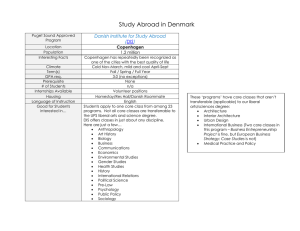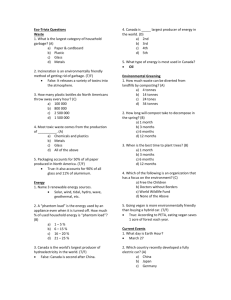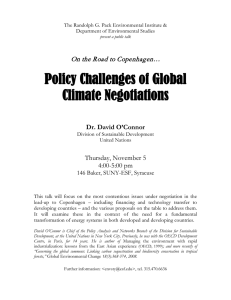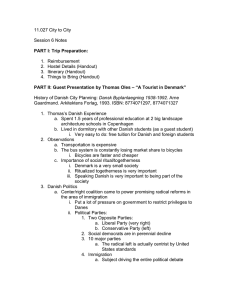Document 17700805
advertisement
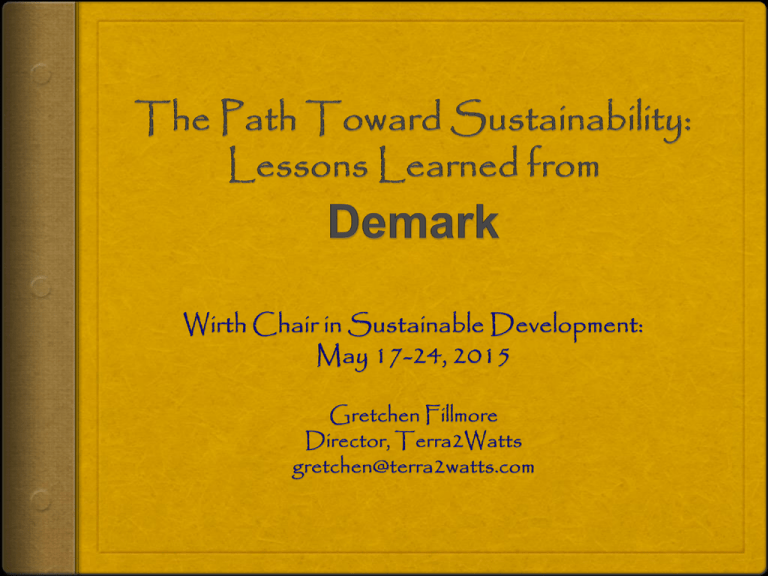
State of Green: & The City Copenhagen State of Green: A Climate Consortium • • Official “Green” Brand for Denmark Danish Government Danish Energy Association The Confederation of Danish Industry Danish Wind Industry Association Explore 1,000 Solutions • Connect with 500 Profiles State of Green: * Bioenergy ~ Water *Wind Power ~ Sustainable Transportation Energy Efficiency Resources & Environment ~ Climate Adaptation Solar ~Intelligent Energy ~ Heating & Cooling * Account for the biggest Renewable Energy Sources in Denmark State of Green District Heating : Bio Gas & Heat Pumps Heating utilizes all energy resources in a flexible mixture of electrical & thermal energy systems Highly cost effective for densely populated areas. Combined efficiency of these power plants will reach 90% Today, 98% of the Danish capital of Copenhagen is supplied by district heating. District Cooling: Cooling~ In Copenhagen largely utilizes sea water from the harbor. Copenhagen's district cooling system reduces Co2 emissions 70% Electricity consumption is reduced by 80% in comparison to conventional cooling Impressive Goals : By 2035 All District Heating will derive from Renewables Example: District Heating Europe's largest district heating solar plant, at 20,000 square meters, is in Marstal, Denmark Example: District Cooling Sea Water Cools Buildings in Copenhagen State of Green: Intelligent Energy Denmark is a World Leader The Power of the Smart Grid: the Key to transformation. Must rethink & reconfigure our energy systems to integrate energy efficiently & socio economic way. Utilize Renewable sources : Wind, Biomass. Communication with Consumers is Key to develop transparent & environmentally friendly – interconnections regions/countries. Smart Grids A strong power grid required to transport the large amounts of Energy to where the energy will be consumed in a world market; Flexible during peak & off peak when energy is cost effective State of Green: Energy Consumption & Green has Gas Emissions Challenges: Transportation Sector Agriculture Non-Energy Intensive Industry Individual Heating in homes Buildings~ Account for 40% of Global Energy Consumption and equally Co2 emissions. It is possible to reduce Energy Consumption by a minimum of 30% & and as much as 80% with Denmark’s initiatives Example: 1 House of Vestas Will Be Europe’s First LEED Platinum Certified Building Inhabitant - Sustainable Design Innovation, Eco Architecture, Green Building House of Vestas- is fitted with Denmark's largest Geo -Thermal installation & is 50% more efficient than other buildings Example: 2 Climate resilient Apartments: Solar panels on rooftop, Green Spaces, Roof top Gardens Rainwater is harvested and flows into the basement for use in: Washing Machines Watering Plants Remaining water is collected at 2 wells so is does not reach sewage system- treated locally. State of Green Holistic Planning & Prioritization Examples in Copenhagen Sea Water Cooling Storm water Drainage Cloudbursts- Rainwater Management Coastal Protection Water Quality Wastewater Treatment Example: 1 Sankt Jorgens Lake: a future Water Reservoir Located in the Middle of Copenhagen; Cloudbursts-is eminent. ~Plan is to lower the water table so the reservoir can spare the sewers. ~Green area development will provide recreational opportunity Example: 2 Copenhagen Harbor: From Sewer to Harbor 11 Underground Tank to collect water & keep the Harbor Clean State of Green Climate Adaption Serious Global Challenges Around the World! The cost of not adapting comes at high cost ~ (EU est. cost at 100 billion Euros in 2020, & 240 billion by 2050. Innovation in Climate Resilient Buildings Coastal Protection Flood Management Creating solid links between Urban Design & Public Health Example 1: St. Kjelde- Copenhagen’s First Climate Adapted Neighborhood No city has ever attempted “climate-change-adapting” to a whole neighborhood by utilizing using just plants and H20. Square of St. Kjeld. This is the first neighborhood in the world to prepare for rising sea levels and other consequences of climate change. o Urban Planning includes: Green roofs, water design/run-off, plants, trees, bicycles o Water is handled locally & H20 does not infiltrate the sewer system Square of St. Kjeld. Blue-Green climate adaptation. (vegetation and water). “The o Green Option” Adding sewers is extremely expensive, so a green-and-blue approach is more economical. Designed at Specific to Levels to anticipate varying Cloud burst Events- 25,50,100,etc State of Green Sustainable Transportation 3 Area of Focus: 1) Reducing Co2 emissions between cars & underground transport 2) Electric vehicles charged by Renewable Energy Sources 3) Biking to Work Cycling in Copenhagen A Danish tradition then… And Now….. Copenhagen Culture of Bikes 5 Bicycles for 1 car: Cars have high tax, You buy 1 car; you pay for 3! ~54 percent % of Copenhagen cyclists ride because it’s quick & easy. ~ 19% Nineteen percent do it for exercise ~1 % for environmental reasons. Ninety percent of Copenhageners own a bike. Only 29 percent of Copenhagen households own a car.* The Danish capital is hoping 50 percent of commuters will get around by bike by 2015 Inspired the world to ’Copenhagenise o Bicycles have displaced more than 1/3 of all transportation fossil fuel use in Copenhagen. o In motion to process, eliminated 90,000 tons of greenhouse gas emissions each year. o Society actually benefits by € 0.16 for every extra kilometer travelled by bicycle instead of by car. Lessons Learned……. Denmark Provides a Model System to other Countries ~ Denmark & the Capital Copenhagen is a global leader in the field of “Climate Adaption” ~ The average Dane uses 6,600 kilowatt hours of electricity a year vs. 13,300 for the average American ~ Inspiration; that as Denmark pop. Increases, strive to maintain their maintaining Co2 Emissions ~ More than 20% of Energy already derives from Renewables~ Denmark taxes energy, so that it will carry thru in the future~ The Goal is to reach 100% by the year 2050 ~ Copenhagen is on track to be the first carbon neutral capital by 2025~ Creating a Green & Sustainable Society is a Key Goal! Mange Tak! Den Effekt Duo! For at gøre denne tur mulig! Mange Tak! Mange Tak! Contact Information: Gretchen Fillmore Director, Terra2Watts gretchen@terra2watts.com
